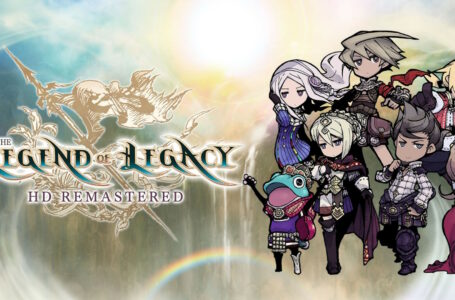Rhapsody: A Musical Adventure is a lightweight but charming RPG that is worth your time
I talked a little about Rhapsody: A Musical Adventure the other day, but having spent some more time with it now, I’d like to say a few more words about it. Specifically, I want to talk about how much I’ve been enjoying it — despite it having a few elements that might put off some of the more “hardcore” RPG fans out there.
For the unfamiliar, Rhapsody: A Musical Adventure is an RPG by Nippon Ichi Software, originally released for PlayStation in 1998 and subsequently rereleased as part of the Prinny Presents NIS Classics vol. 3 compilation for Nintendo Switch. It’s also available as a standalone release on PC via Steam.
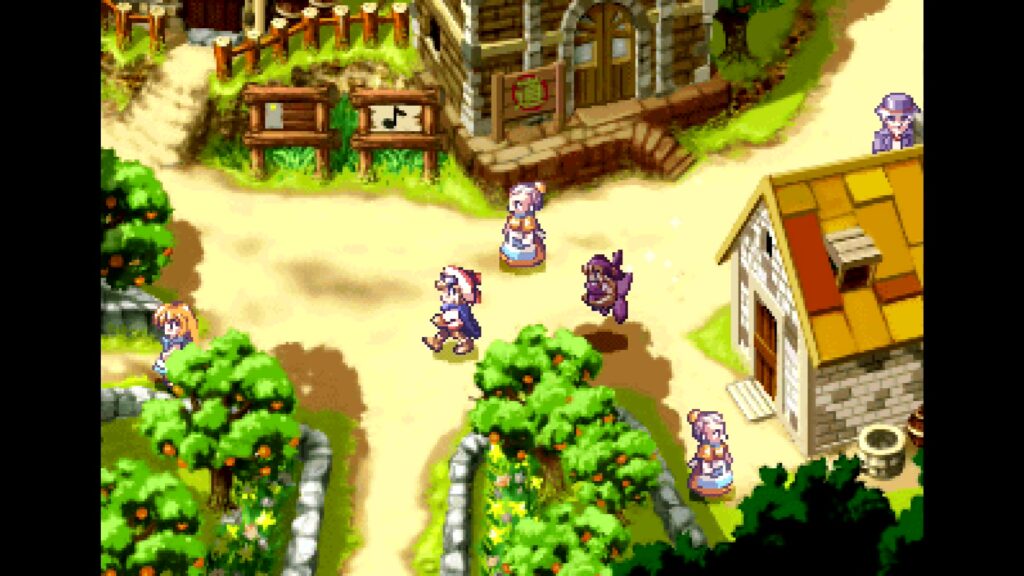
It’s actually part of a series of three games known as the Marl Kingdom trilogy, but sadly we only ever saw this first one localised. Fingers crossed that Rhapsody’s recent resurrection means that Nippon Ichi Software and their western arms will at least consider localising the others for the first time, perhaps for a future volume of the Prinny Presents NIS Classics series.
In Rhapsody, you take on the role of a girl named Cornet, who lives in a small village named Orange. Cornet has a couple of distinctive things about her: firstly, she has a horn (be quiet) that grants wishes; secondly, she can talk to puppets; and thirdly, she has an inseparable flying puppet partner named Kururu, who is a rare example of a puppet who is able to talk normally with regular people.
As Rhapsody begins, Cornet has been troubled by regular dreams of a handsome prince, and, after some early misadventures, discovers that the man of her dreams actually exists: he’s Prince Ferdinand of Marl Kingdom. As luck would have it, an opportunity to win the hand of this dreamboat arises in the city of Mothergreen, as an annual beauty competition promises that the winner will at least be considered very carefully for marriage by Ferdinand.
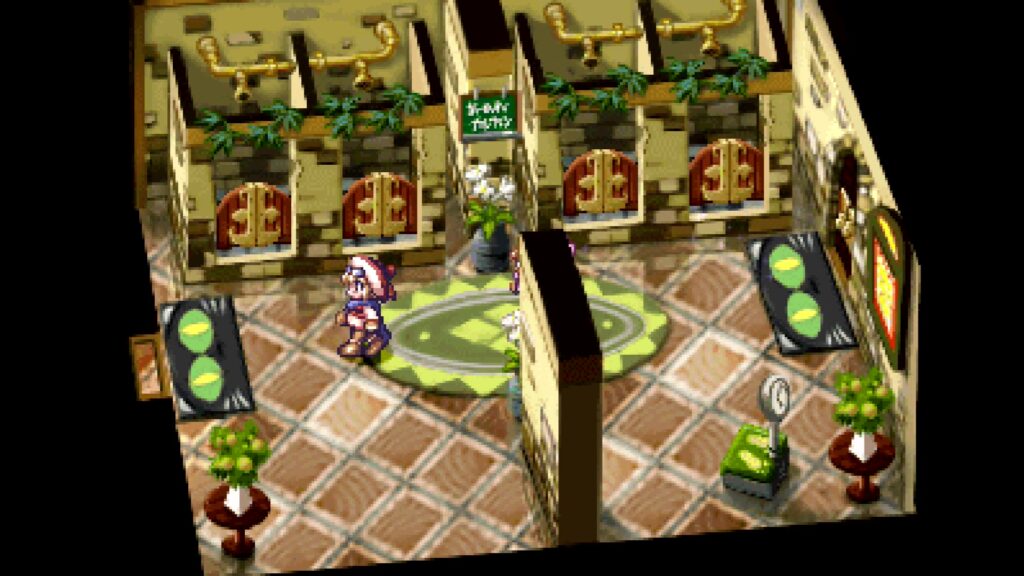
Despite some amusing, comical mishaps along the way — mostly courtesy of Cornet’s longstanding rival, the ohohoho-ing ojou Etoile — Cornet manages to catch the eye of Ferdinand, but just as their love is beginning to blossom, disaster strikes! Our prince is turned to stone by the evil witch Marjoly and her cronies, and then snatched away when Marjoly realises that she doesn’t really know how to reverse the curse she just cast.
Yes, Rhapsody is not a game that takes itself altogether seriously, but if you have any experience with Nippon Ichi Software games this is likely exactly what you were expecting. And despite Rhapsody being one of the company’s earlier games, it’s packed with the same amount of charm and wonderful characterisation that its more well-known later games (such as the Disgaea series) are well known for.
Then there’s that “Musical Adventure” part. Rather delightfully, the game was deliberately composed as a musical, meaning that as the narrative progresses, the cast often break into some absolutely delightful song and dance numbers. There’s no interactivity to these musical numbers — they’re just part of the game’s overall presentation — but it’s honestly something I’m surprised we haven’t seen explored more, particularly in the RPG genre.
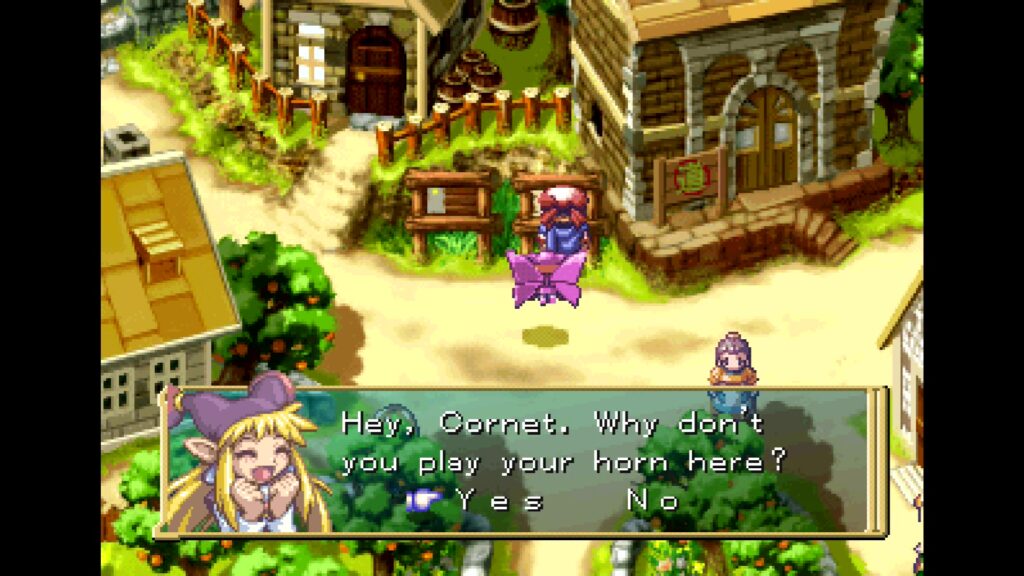
There’s no speech throughout Rhapsody — despite coming on CDs, most PS1 RPGs opted to save space by omitting a voice track for their often substantial scripts — but the songs can be enjoyed in either English or Japanese. Interestingly, in stark contrast to how subs versus dubs discussions usually go, Rhapsody’s English songs appear to be quite commonly agreed by almost everyone to be superior to their Japanese counterparts.
Gameplay-wise, Rhapsody is a much more conventional RPG than one might typically expect from latter-day Nippon Ichi Software. The company themselves describe it as the roots of the Disgaea series, but that paints a rather grander picture of the game’s strategic element than actually exists; rather, what we have here is a mid-budget PS1 RPG that happens to feature a cool tactical combat system.
What does that mean? Well, rather than the game being split into discrete “missions”, you instead explore Rhapsody’s world relatively freely, following the story along as you go. Locations unlock gradually as you progress — usually triggered by having a conversation with a specific NPC — though you’ll often find a couple of areas that aren’t directly critical to the story will also appear at times. These are worth exploring when they come up, as they often reward you with new puppets to join your party.
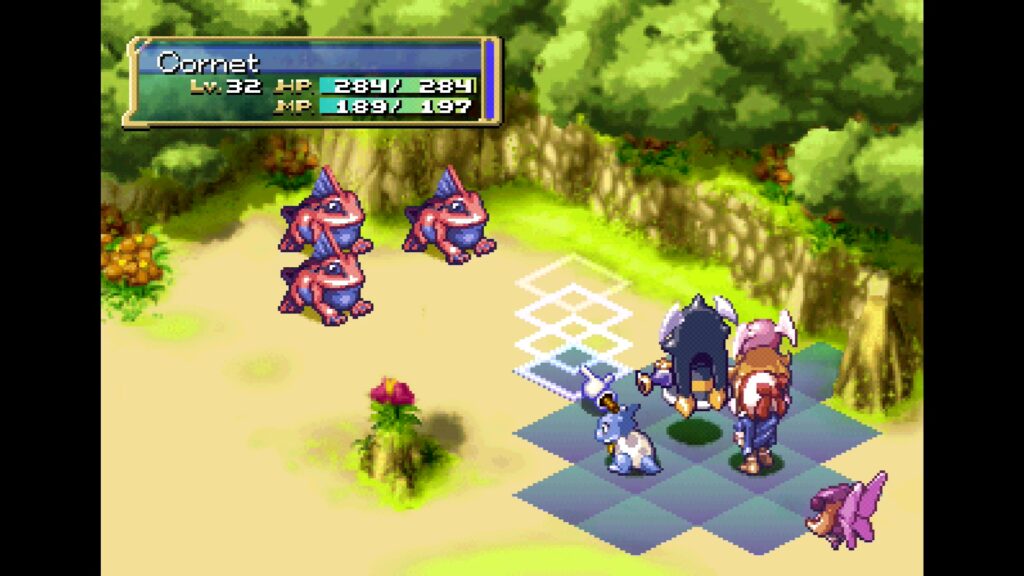
In “dungeon” areas, you’ll face random encounters every so often, and story sequences often conclude with a battle sequence. In both cases, these unfold in the same way: Cornet and up to three of her allies appear on one side of an isometric battlefield based on the area you’re in, and up to four enemies appear on the other side.
You then take it in turns to move by square and then perform actions including basic attacks (both melee and ranged according to characters), casting spells, using special abilities and, in Cornet’s case, using her horn to both buff the puppets standing near her and charge her own special ability bar.
The battlefields are fairly simple, but some interest is added by obstacles and scenery features according to the area you’re fighting in. There’s no need to worry about things like elevation, though, and the battlefields are never larger than a screen in size, so moving around is mostly about positioning yourself optimally to use area-of-effect skills or avoid the enemies’ attacks.
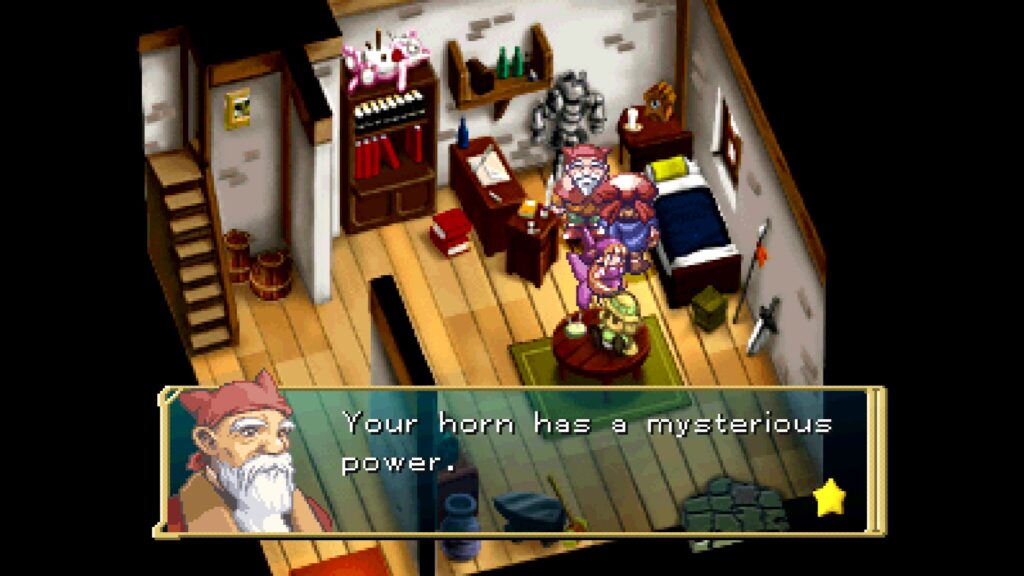
The main issue with Rhapsody is that it’s way too easy on its default settings. It’s not hard to find yourself considerably outlevelling the story without even making a specific effort to grind, and that makes most combat encounters — including “boss” battles — almost laughably trivial. There are a couple of interesting considerations even if you’re in this situation — most notably Cornet’s ability to capture monsters if she’s the one to dispatch them with a normal attack — but chances are you’ll spend a lot of the early game at least considerably outlevelling the challenges before you.
That said, the fact that there are a variety of monsters to capture as well as puppets to recruit means that the combat system isn’t entirely worthless; new party members join you at level 1 regardless of who they are, so you’ll need to have them at least participate in a few battles to get them up to a suitable fighting standard, and if you want to give yourself a challenge you can always deliberately make use of lower-level party members or those you find less effective. With only four active party members and considerably more recruitable characters available, there’s plenty of scope for experimenting a bit with different party compositions — just no real need to.
But then one could argue that Rhapsody was never intended to be a super-challenging RPG, and that one can easily tell that from its wonderfully whimsical, light-hearted nature. I’d be inclined to agree with that — but I’d also add that the game throws up some interesting challenges in other respects outside of combat.
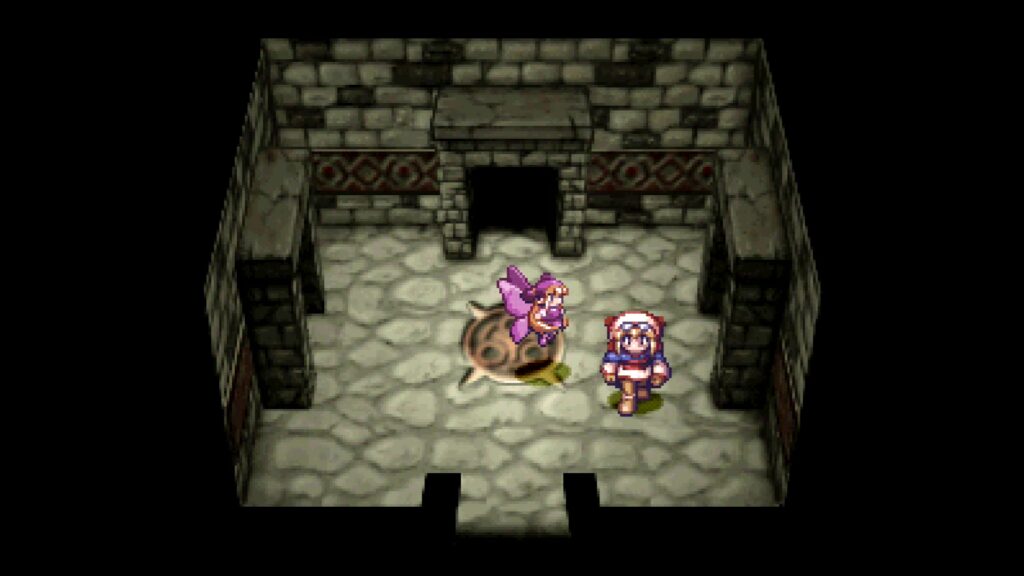
Most notable among these is how the dungeons are implemented. Rather than using unique, pre-drawn screens for each dungeon, the majority of Rhapsody’s dungeons instead make use of more generic screens depicting passages heading off in multiple directions, with several different “tilesets” seen throughout the game.
Not one of these dungeons, not even in the early game, is a simple “straight line to the finish” sort of affair. While they’re not quite of a level of complexity that you’ll need to map them on paper in order to progress — there’s no in-game map — you will at least need to explore them in a logical manner if you want to find all the important things hidden within. And while most of these dungeons include a lot of useless dead ends, many of them also conceal helpful treasures and even new party members.
While it’s a bit of a shame that the graphics for the dungeons are re-used quite as often as they are over the course of Rhapsody, the actual map layouts of the various dungeons makes them consistently interesting to explore. In most cases, there’s a strong feeling that successfully negotiating a dungeon in Rhapsody is a puzzle of sorts, and that makes it very satisfying when you do finally clean them out of treasures and/or discover the events waiting for you within.
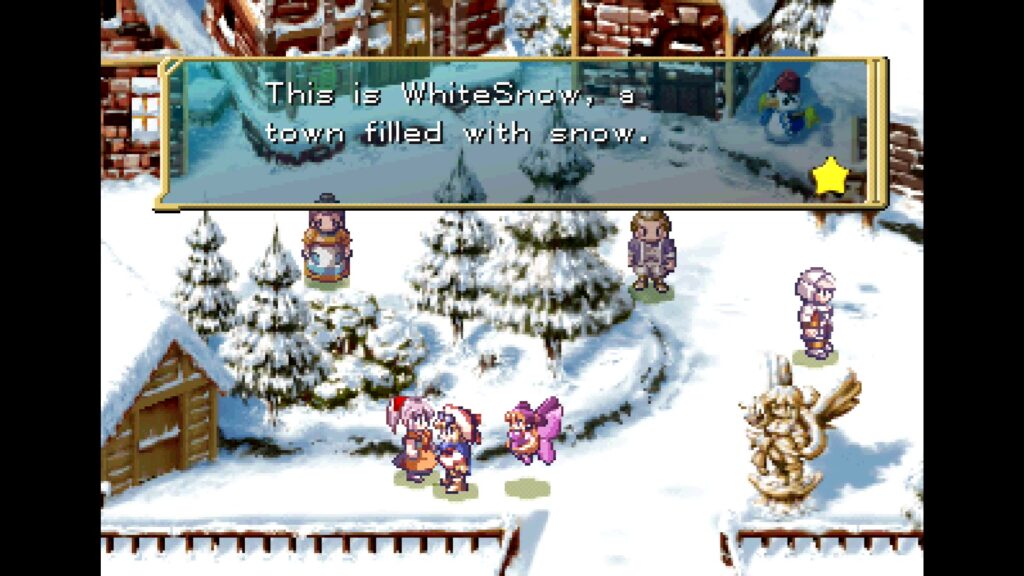
Ultimately, the core appeal of Rhapsody lies in its atmosphere and script. The game is full of memorable, incredibly likeable characters who all have some interesting depth to them. Some of the various events you get involved with over the course of the game — particularly in the non-linear middle section, where you can approach the various “quests” in whatever order you please — feel like they’re over a bit before they’ve really had their full narrative context explored, but the development of major characters like Cornet, Kururu and Etoile over the length of the entire game more than makes up for this.
There’s also a lot of fun background detail in the non-important NPCs. As you progress through the game, they’ll also go through their own little story arcs, including moving from location to location and having fairly major things happening in their lives. This starts right from the beginning of the game, where you can meet a completely unimportant girl in Cornet’s home village of Orange.
This girl wants to move to the big city, and as you progress through the main narrative, she successfully raises the money to move, gets married and subsequently finds herself struggling with her husband’s impotence, despite them both wanting to start a family. And this is just one of many ongoing stories that you can just stumble across by chatting to NPCs with each new place you visit. It’s little touches like this that make Rhapsody’s world feel truly “alive”, despite being depicted with very limited tech by modern standards.
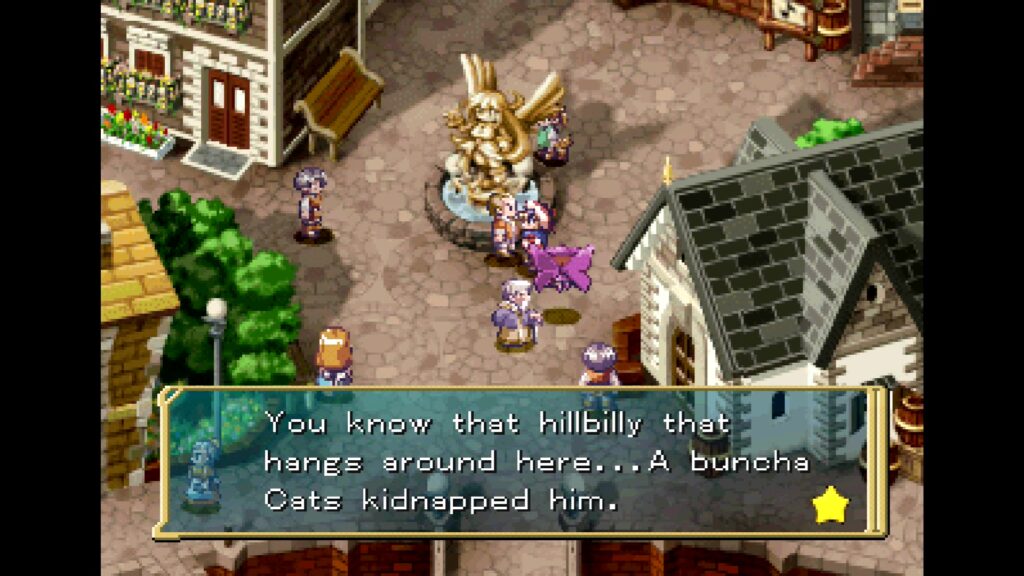
To sum all the above up, you shouldn’t play Rhapsody if you want a challenge, or particularly deep RPG mechanics. You should, however, play it if you enjoy just spending time in a lovingly crafted world with some truly wonderful characters. In this latter aspect, it actually reminds me quite a bit of Falcom’s Trails in the Sky series; Cornet and Estelle feel like they’d get along well (or perhaps end up in a screaming catfight within five minutes), for example, and the overall sense of the world being a “real” place is very similar.
It’s a shame we’ve never been able to see how the story continues in English with the subsequent two games, but as noted above, perhaps with the release of Prinny Presents NIS Classics vol. 3, Nippon Ichi and their western partners will consider some brand new localisations for modern audiences. There’s always a market for good RPGs, after all — and there’s something wonderfully distinct about RPGs from this late ’90s/early ’00s period, with Rhapsody being a fantastic demonstration of that.
Rhapsody: A Musical Adventure is available for PC via Steam, and as part of Prinny Presents NIS Classics vol. 3 for Nintendo Switch. Physical versions of the latter are available.
Join The Discussion
Rice Digital Discord
Rice Digital Twitter
Rice Digital Facebook
Or write us a letter for the Rice Digital Friday Letters Page by clicking here!
Disclosure: Some links in this article may be affiliate links, which means we may earn a small commission if you make a purchase after clicking on them. This is at no additional cost to you and helps support Rice Digital!
- Letter from the Editor: passing the torch - June 30, 2023
- Super Woden GP 2 is looking promising - June 30, 2023
- Inti Creates is making a 32 bit-style Love Live action platformer - June 26, 2023




